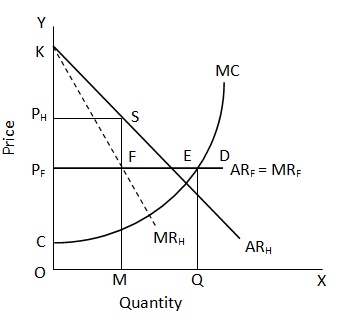Dumping is a special case of price discrimination where a producer sells a part of output at a high price in the home market and the remaining part of the output at a low price in the foreign market. The home market may be controlled and therefore the producer may have a monopoly position in this market. Therefore, he can charge a high price in the home market. But the foreign market is beyond his control, he may be facing a tough competition in the world market. Having no monopoly position in the world market, he is obliged to sell only at lower competitive price in that market. Thus, he is faced with two different types of demand curve. In the home market, where he is a monopolist, the demand curve (AR curve) for the produced is downward sloping. But in the foreign market, where he is a competitor, the demand curve (AR curve) for his product is a straight line parallel to X – axis, as is the case when there is perfect competition.
The theory of price determination in the case of discriminating monopoly states that a discriminating monopolist will be maximizing his profits when he fixes his output at a level where the aggregate marginal revenue (the marginal revenue in Market I and the marginal revenue in Market II added up together) is equal to his marginal cost. The same theory applies to the case falling marginal revenue curve (corresponding to the falling ARH curve) in the home market and a straight line MR curve (corresponding to and coinciding with RAF curve) in the foreign market.

ARH is the home demand curve and MRH is the marginal revenue curve in the home market. ARF is the foreign demand curve and MRF the marginal revenue curve in the foreign market coincides with it. The aggregate marginal revenue curve is the sum of MRH and MRF which is shown by KFD. The marginal cost curve MC intersects with this aggregate marginal revenue curve KFD at point E. hence, E is the point of equilibrium since aggregate marginal revenue is equal to marginal cost at this point. Corresponding to be distributed between the home market and the foreign market. This distribution is done in such a way that the marginal revenue in the two markets is equal to each other and also equal to marginal cost QE. This equality takes place at point F on the MRH curve. At this point, sale in the domestic market is OM where marginal revenue is FM which is equal to marginal cost EQ. hence, the producer will sell OM amount in the home market. The price at which this output will be sold as indicated by the home average revenue curve ARF . Thus, the monopolist sells a smaller amount OM in the home market and charges a higher price OPH because home demand is less elastic. In the foreign market, where demand is perfectly elastic, he sells a higher amount MQ at a much lower price PF. And since the producer is charging a lower price in the foreign market. His total profits (from both the markets together) would be equal to the area KFEC.
SUBMIT ASSIGNMENT NOW!